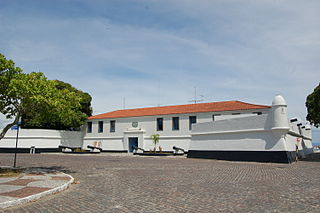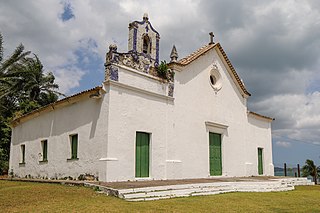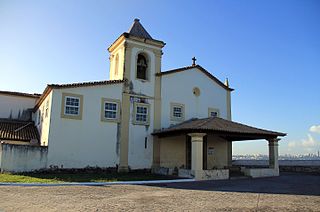
Cairu is a municipality in the state of Bahia in the North-East region of Brazil. The municipality consists of three islands: the Island of Cairu, which is only separated from the mainland by a narrow river; Tinharé Island, which has the dense tourist settlement of Morro de São Paulo to the north; and Boipeba Island.

São Marcelo Fort, also known as Forte de Nossa Senhora do Pópulo e São Marcelo or Forte do Mar, is located in Salvador in Bahia, Brazil. It is located in small bit of land off the coast in the Baía de Todos os Santos. Standing on a small bank of reefs about 300 metres (980 ft) from the coast, it is one of two forts separated by water from land in Brazil, the other being the Fort Tamandaré da Laje Tamandaré in Rio de Janeiro. It is the only cylindrical fort in Brazil. Its design follows those of Castel Sant'Angelo in Italy and São Lourenço do Bugio Fort in Portugal. It is popularly known as the "Forte do Mar". It was built to protect the important port city Salvador from threats; the city had the largest number of forts during the colonial period of Brazil.

The Archbishop's Palace of Salvador is a Roman Catholic residence in Salvador, Bahia, Brazil. It is located on the Praça da Sé in the Pelourinho historical district of the city. The palace was built in the early eighteenth century and is one of the best examples of Portuguese colonial-period civil architecture in Brazil. The Archbishop's Palace was listed as a historic structure by the National Historic and Artistic Heritage Institute in 1938. IPHAN transferred ownership of the palace to the Roman Catholic Archdiocese of São Salvador da Bahia in 2011. The palace sits within the UNESCO World Heritage Site of the Historic Center of Salvador. Part of the structure was converted into a cultural center, the Cultural Center of the Palácio da Sé, which opened in 2020.

Forte de Santo Antônio da Barra is a fort located in Salvador, Bahia, Brazil. It was constructed to guard the entrance to the Bay of All Saints, during the time of the Portuguese Empire. The first Portuguese fortification erected in Bahia was likely built in 1501, in the same area now occupied by the Forte de Santo Antônio da Barra. The foundation stone of that first fortification was placed in an area called Ponta do Padrão, now known as the Largo do Farol da Barra, the broad public square in front of the fort. The fort also houses the 22 metres (72 ft)-high Barra Lighthouse and the Nautical Museum of Bahia. The Santo Antônio da Barra Fort is protected as a historic structures by the National Institute of Historic and Artistic Heritage.

Forte de Santo Antônio Além do Carmo is a fort located in Salvador, Bahia, Brazil. It is variously known as the Forte da Capoeira, State Prison. The fort defended the northern limit of Salvador at its time of construction 17th century.

Forte de São Lourenço is a fort located in Itaparica, Bahia in Brazil. It sits on a strategic point at the north of Itaparica Island on a site used for whaling in the early 17th century. The Dutch constructed a small earthwork fortification on the site during the Dutch occupation of Brazil (1630–1654); it was reconstructed by the Portuguese in its present form in the early 18th century. The fort was used by Brazilian forces during the Brazilian struggle for independence in 1823; the Brazilian Navy has owned the fort since the same year. The Forte de São Lourenço was listed as a federal historic structure in 1938.

The Parish Church of Saint Bartholomew is a 17th-century Roman Catholic church located in Maragogipe, Bahia, Brazil. The church is dedicated to Bartholomew the Apostle and belongs to the Roman Catholic Archdiocese of São Salvador da Bahia.

The Chapel of Our Lady of the Snows is a 16th-century Roman Catholic church located on the Ilha de Maré in the Bay of All Saints, Bahia, Brazil. The island is administratively part of the city of Salvador. The chapel is dedicated to Blessed Virgin Mary and belongs to the Roman Catholic Archdiocese of São Salvador da Bahia. Its construction is dated to 1552, and is among the oldest existing churches in Brazil. It was part of the sugar plantation of André Fernandes Margalho. The nave of the church is narrow, measuring only 6 metres (20 ft) by 15 metres (49 ft). The church was listed as a historic structure by the National Historic and Artistic Heritage Institute in 1958. The historian Mário Mendonça de Oliveira calls it "one of the gems of old Brazilian religious architecture".

The Church and Monastery of Our Lady of Monserrate is a 16th-century Roman Catholic church and monastery located in Salvador, Bahia, Brazil. The church and monastery are dedicated to Our Lady of Monserrate and belongs to the Roman Catholic Archdiocese of São Salvador da Bahia. It is located 200 metres (660 ft) from the Fort of Monserrate on a rock on the Itapagipe Peninsula. The date of construction of the structure is disputed; it dates to the 16th century, and has seen numerous alterations. The church was built either by the Spanish, or by the group that constructed the Garcia d'Ávila Tower House. Its design, along with that of numerous rural chapels of Bahia, is attributed to the Italian architect Baccio da Filicaia (1565-1628). The church interior was once lined entirely with 16th-century azulejos; now only a single strip of the tiles remain. The church was listed as a historic structure by the National Historic and Artistic Heritage Institute in 1958. It and the Chapel of Our Lady of the Ladder are the only remaining 16th-century chapels in Salvador.

The Church and Hospice of Our Lady of the Good Journey is an 18th-century Roman Catholic church located in Salvador, Bahia, Brazil. The church is dedicated to Our Lady of the Good Journey and belongs to the Roman Catholic Archdiocese of São Salvador da Bahia. It is located on the Itapagipe Peninsula and faces west directly onto the Bay of All Saints. The Church and Hospice of Our Lady of the Good Journey has a single tower with a frontispiece covered in blue and white azulejos in a zigzag pattern. It was listed as a historic structure by the National Historic and Artistic Heritage Institute (IPHAN) in 1938.

The Church of the Blessed Sacrament of Saint Anne is an 18th-century Roman Catholic church located in Nazaré, Salvador, Bahia, Brazil. The church is dedicated to Saint Anne and belongs to the Roman Catholic Archdiocese of São Salvador da Bahia. Its construction began in 1747 and continued over the next two decades. The church sits on the second line of hills below the Historic Center of Salvador in the neighborhood of Nazaré. It was built on a hill above the Gravatá Fountain, which likely dates to the early 18th century. The church has a single nave with no side chapels; the side aisles are surmounted by tribunes. The transept features a cupola with a skylight, a feature unique in Bahia. The rear of the church has an ossuary constructed around a small courtyard. The church was listed as a historic structure by the National Historic and Artistic Heritage Institute in 1941.

The Chapel of Our Lady of the Ladder is a 16th-century Roman Catholic church located in Salvador, Bahia, Brazil. It was constructed as part of the Nossa Senhora de Escada sugar plantation by Lázaro Arévolo, likely in 1566; he donated the chapel to the Jesuits in the late 16th century. The chapel is part of the Roman Catholic Archdiocese of São Salvador da Bahia; it was listed as a historic structure by the National Institute of Historic and Artistic Heritage (IPHAN) in 1962. It and the Church and Monastery of Our Lady of Monserrate are the only remaining 16th-century chapels in Salvador.

The Church of Saint Antony of Barra is a 17th-century Roman Catholic church in Salvador, Bahia, Brazil. It is one of three churches in Salvador dedicated to Saint Anthony of Padua and belongs to the Roman Catholic Archdiocese of São Salvador da Bahia. The church was likely founded in the 17th century on a point overlooking the Bay of All Saints. It features a simple Renaissance-style façade, nave, chancel, sacristy, and other rooms.

The Church and Convent of Our Lady of Mount Carmel is a 17th-century Roman Catholic church and former convent in Salvador, Bahia, Brazil. The church is dedicated to Our Lady of Mount Carmel. The complex is adjacent to the Church of the Third Order of Mount Carmel. The Church and Convent of Our Lady of Mount Carmel was listed as a historic structure by National Institute of Historic and Artistic Heritage (IPHAN) in 1938 and is part of the Historic Center of Salvador UNESCO World Heritage Site.

The Garden of Hospital São João de Deus is an abandoned garden in Cachoeira, Bahia, Brazil. It is part of the São João de Deus Hospital architectural ensemble that includes a hospital building, a large Baroque-style church of the early 18th century that faces Praça Dr. Aristides Milton, and a set of houses built by the Santa Casa da Misericórdia along Rua Durval Chagas. The garden is located to the rear of the chapel. The garden was listed as a historic structure by National Institute of Historic and Artistic Heritage (IPHAN) in 1938; five of the ceramic objects that crown the columns of the garden were listed separately the same year.

The Convent of Bom Jesus dos Perdões and Chapel of Mercy is an 18th-century Roman Catholic church and convent located in Salvador, Bahia, Brazil. It was listed as a historic structure by National Institute of Historic and Artistic Heritage (IPHAN) in 1943 and is a contributing property of the Historic Center of Salvador UNESCO World Heritage Site.

The Church and Monastery of Our Lady of Grace is an 18th-century Roman Catholic church located in Salvador, Bahia, Brazil. The church is dedicated to Our Lady of Grace and is part of the Roman Catholic Archdiocese of São Salvador da Bahia; it is owned and managed by the Mosteiro de São Bento. It was listed as a historic structure by the National Historic and Artistic Heritage Institute (IPHAN) in 1938.

The Chapel of Loreto is a 17th-century Roman Catholic church located on the Ilha dos Frades, in the Bay of All Saints, Brazil. The island is within the limits of the municipality of Salvador. It is dedicated to Our Lady of Loreto. The architect Mário Mendonça de Oliveira describes it as "a highly elegant building, with a sophisticated design and an attractive coastal setting on the Island of Frades." The building is protected as a historic structure by the state of Bahia.

The São Paulo da Gamboa Battery is a military fortification located in Salvador, Bahia in Brazil. It is also known as the Fort of São Paulo da Gambôa, or simply the Fort of Gambôa. The battery was built in the early 17th century as part of a series of military fortifications in Salvador by Jean Massé, a French military engineer. The battery was built as an extension of the Fort of Saint Peter; it functioned to defend the city against Dutch and French attacks. The battery was listed as a historic structure by the National Institute of Historic and Artistic Heritage (IPHAN) in 1938. Despite its listing as a federal historic structure, it is not under the care of any public agency or institution. The battery is in an advanced state of disrepair, occupied by informal settlements, and is below a slope prone to landslides.

The Fort of Monserrate is a military fortification located in Salvador, Bahia in Brazil. It is also known as the Small Fort of Our Lady of Monserrate. It was known as the Forte de São Felipe from the time of its construction until the 19th century. The Fort of Monserrate was built between the end of the 16th century and early 17th century on the Itapagipe Peninsula. It is "one of the few Brazilian fortifications to retain its original appearance from the late 16th century." The fort is located above the Church and Monastery of Our Lady of Monserrate, one of the oldest church structures in Brazil. The fort was listed as a historic structure by the National Institute of Historic and Artistic Heritage (IPHAN) in 1938.





















